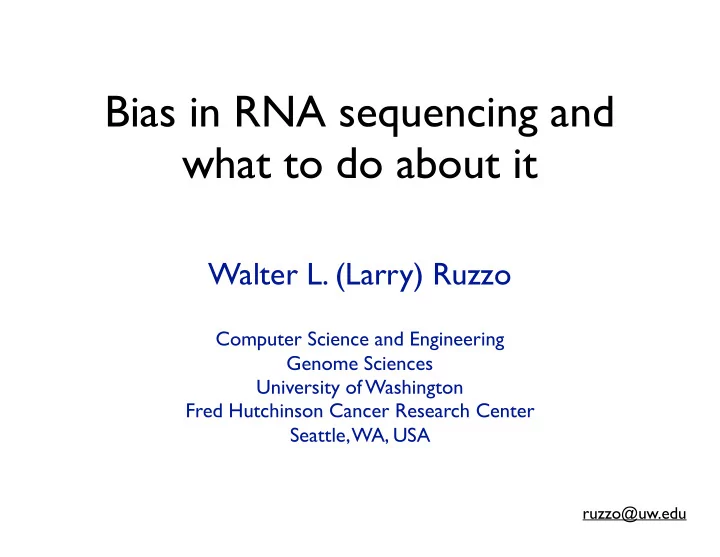

Bias in RNA sequencing and what to do about it Walter L. (Larry) Ruzzo Computer Science and Engineering Genome Sciences University of Washington Fred Hutchinson Cancer Research Center Seattle, WA, USA ruzzo@uw.edu
⬇ RNAseq ⬇ ⬇ Millions of reads, DNA Sequencer say, 100 bp each map to genome, map to genome, analyze compare & analyze 2
Goals of RNAseq 1. Which genes are being expressed? How? assemble reads (fragments of mRNAs) into (nearly) full-length mRNAs and/or map them to a reference genome 2. How highly expressed are they? How? count how many fragments come from each gene–expect more highly expressed genes to yield more reads per unit length 3. What’s same/diff between 2 samples E.g., tumor/normal 4. ... 3
RNA seq cDNA, fragment, QC filter, RNA → → S equence → → C ount end repair, A-tail, trim, map, ligate, PCR, … … It’s so easy, what could possibly go wrong?
What we expect: Uniform Sampling 100 Count reads starting at each position, not those covering each position 75 50 25 0 0 50 100 150 200 Uniform sampling of 4000 “reads” across a 200 bp “exon.” Average 20 ± 4.7 per position, min ≈ 9, max ≈ 33 I.e., as expected, we see ≈ μ ± 3 σ in 200 samples
What we get: highly non-uniform coverage The bad news : random fragments are not so uniform. E.g., assuming uniform, the 8 peaks above 100 are > +10 σ above mean ~ Count reads starting at Uniform each position, not those 50 25 covering each position 0 Actual ––––––––––– 3’ exon ––––––––– 200 nucleotides Mortazavi data
What we get: highly non-uniform coverage The bad news : random fragments are not so uniform. E.g., assuming uniform, the 8 peaks above 100 are > +10 σ above mean ~ Count reads starting at Uniform each position, not those 50 25 covering each position 0 Actual How to make it more uniform? A: Math tricks like averaging/smoothing (e.g. “coverage”) or transformations (“log”), …, or WE DO B: Try to model (aspects of) causation ––––––––––– 3’ exon ––––––––– THIS (& use increased uniformity of result as a measure of success) 200 nucleotides Mortazavi data
What we get: highly non-uniform coverage The Good News : we can (partially) correct the bias The bad news : random fragments are not so uniform. Uniform 50 25 0 Actual not perfect, but better: 38% reduction in LLR of uniform model; hugely more likely 200 nucleotides
(in part) Bias is ^ sequence-dependent Reads and platform/sample-dependent Fitting a model of the sequence surrounding read starts lets us predict which positions have more reads.
what causes bias? No one knows in any great detail Speculations: all steps in the complex protocol may contribute E.g., primers in PCR-like amplification steps may have unequal affinities (“random hexamers”, e.g.) ligase enzyme sequence preferences potential RNA structures fragmentation biases mapping biases 10
some prior work Hansen, et al. 2010 “7-mer” method - directly count foreground/ background 7-mers at read starts, correct by ratio 2 * (4 7 -1) = 32766 free parameters Li, et al. 2010 GLM - generalized linear model } training requires gene MART - multiple additive regression trees annotations 11
d sample foreground sequences o ( a ) h e t n e i M l t sample (local) background sequences ( b ) u O train Bayesian network ( c ) I.e., learn sequence patterns associated w/ high / low read counts. ( d ) ( e )
defining bias Data is Un biased if read is independent of sequence: Pr( read at i ) = Pr( read at i | sequence at i ) From Bayes rule: Pr( seq at i | read at i ) Pr( read at i | seq at i ) = Pr( read at i ) Pr( seq at i) We define “bias” to be this factor 13
Modeling Sequence Bias Want a probability distribution over k-mers, k ≈ 40? Some obvious choices: Full joint distribution: 4 k -1 parameters PWM (0-th order Markov): (4-1)•k parameters Something intermediate: Directed Bayes network 14
Form of the models: Directed Bayes nets One “node” per nucleotide, ±20 bp of read start • Filled node means that position is biased • Arrow i → j means letter at position i modifies bias at j • For both, numeric parameters say how much How–optimize: n n Pr [ s i | x i ] Pr [ x i ] � � ℓ = logPr [ x i | s i ]= log � x ∈ { 0 , 1 } Pr [ s i | x ] Pr [ x ] i = 1 i = 1
NB: •Not just initial hexamer •Span ≥ 19 •All include Illumina ABI negative positions •All different, even on same platform
Result – Increased Uniformity Kullback-Leibler Divergence Jones Li et al Hansen et al Trapnell Data
Result – Increased Uniformity R 2 Fractional improvement in log-likelihood under hypothesis test: uniform model across * = p-value < 10 -23 “Is BN better than X?” 1000 exons (R 2 =1-L’/L) (1-sided Wilcoxon signed-rank test)
some questions What is the chance that we will learn an incorrect model? E.g., learn a biased model from unbiased input? How does the amount of training data effect accuracy of the resulting model? 19
Recommend
More recommend